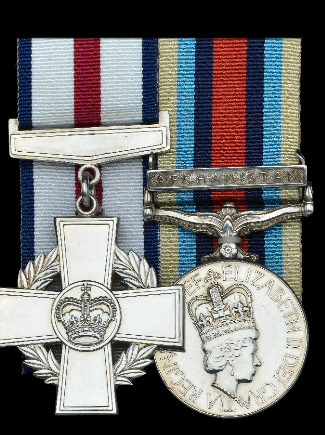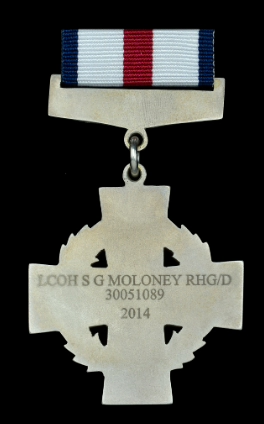b. 1990 St Albans, Hertfordshire.
DATE OF CGC ACTION: 07/2013 Yakhchal, Afghanistan.
Lance Corporal Moloney of The Royal Horse Guards and 1st Dragoons (Blues and Royals), Household Cavalry, was part of a troop which, with Afghan Army partners, landed by helicopter deep in the insurgent stronghold of Yakhchal as part an operation to gather intelligence and disrupt the enemy. At first light they broke into an enemy command compound but soon came under fire. The former Sandringham School pupil and a machine gunner were tasked to provide cover watch from the domed roof to allow the troop to move on to a second target.
With attack helicopters moving away, the enemy increased their machine gun fire, using it to mask the accurate fire of a sharp shooter, whose bullets regularly came within a metre of Lance Corporal Moloney. Knowing his troop were now in contact and that cover was vital, he held his nerve and position despite the increasing threat to his own safety. However, the insurgent sharpshooter found his target and a bullet ripped through his neck, miraculously parting his trachea and carotid artery, missing his vital arteries and voice box by millimetres and hurling him from the rooftop with the force of the impact.
Lance Corporal Moloney said: “It felt as though I’d been punched. I was half-thrown and half rolled off the roof. “With the amount of fire coming in, if I had stayed up there I would have taken more bullets.” The surgeon who treated him later said he would struggle to make such an incision on the operating table and the odds of the bullet taking that path were a trillion-to-one.
In a further slice of fortune for Lance Corporal Moloney, his fall from the 8ft-high roof top was broken by a goat. Unfortunately, the animal didn’t fare as well, the impact of all 100kg of Lance Corporal Moloney and his protective gear killing it. As the machine gunner dropped from the roof to race to Moloney’s aid, the severity of enemy fire increased, engaging the troops from three sides and pinning them down. Small arms fire and rocket-propelled grenades smashed into the compound walls and flew overhead from around 15 firing points. The situation worsened as communications with supporting artillery failed, leaving Lance Corporal Moloney’s section isolated and surrounded by an enemy proving difficult to locate. He was then forced to climb back on to the roof to retrieve the radio and call in his own injuries while the gunner, who had given him initial treatment provided covering fire.
As Lance Corporal Masters, a Private at the time, who had run 400-metres under fire after hearing his friend had been shot, arrived and applied improvised first aid to Lance Corporal Moloney due to the nature of his injuries, multiple under-slung grenades began exploding inside the compound, landing within four metres of the troops. Lance Corporal Masters said: “You aren’t supposed to survive that sort of bullet wound and so I needed to fashion a bandage that would stop bleeding and infection but not block Simon’s air-way.”
Aware of the severe danger they were now in, without prompting, Lance Corporal Moloney reoccupied the position in which he had been shot ten minutes earlier, identifying and engaging the enemy positions. He immediately brought the fire support under control, suppressing the insurgents. “I was angry one of them had shot me,” he said. “But I didn’t feel relief that I hadn’t died for one second. Because of the amount of enemy fire we were under, if anything, I thought my time was up.”
Shouting through the effects of his throat injury and over the crackle of enemy sniper rounds repeatedly hitting the roof and walls around him, he passed vital target information to win the firefight. Lance Corporal Moloney only broke contact when ordered to, so that the medic could check his dressings. Once done, he immediately returned to his position on the roof, still under accurate fire and continued fighting for more than 90 minutes in temperatures exceeding 40°C until, against his will, he was extracted by helicopter. Lance Corporal Moloney and Lance Corporal Masters, already friends before, have become inseparable since.
Lance Corporal Moloney said: “I owe him my life and have complete trust in him and he knows he can trust me. We have spent every single day since then together. “And we both have the courage and professionalism of everyone who fought with us that day to thank as otherwise we would never have survived.” In a further twist of fate, it was Lance Corporal Moloney’s last operation half way through his tour before he was due two weeks back home. As it transpired, he was allowed three to recover. Lance Corporal Moloney’s citation states: “Moloney’s actions in the face of a determined enemy and with little thought for his gunshot wound, were an inspiration to his troop. “In his utter determination to protect others and in total disregard for his own life, he displayed extreme valour. “Without his gallantry and skill in the ruthless suppression of the enemy it is likely that this troop would have sustained multiple casualties.”
Simon left the Army soon after his CGC was announced. He decided to start his own business, and as a result, chose to sell his medals at auction to put the money to support his venture. On 9 May 2018, his medal group was sold at Noonan’s, in Mayfair, London for a hammer price of £130,000. Simon is now a Project Manager at WMS Firearms Training Ltd.
CGC CITATION:
During a helicopter assault operation to gather intelligence and to disrupt the enemy, Lance Corporal Moloney’s troop and their Afghan Army partners landed in darkness, deep in an insurgent stronghold. At first light they broke into their target compound and were soon met by sporadic and inaccurate fire which began to harass his troop. Moloney and a machine-gunner were tasked to provide over watch from the domed compound roof to allow the troop to move onto another target.
At 06:20 hours, Moloney suffered a gunshot wound to the neck from an enemy sharpshooter, missing his vital arteries and voice box by millimetres, and throwing him off the roof. As the machine-gunner dropped down from the rooftop to aid Moloney, the rate and severity of enemy fire increased as they engaged the troops from three sides, pinning them down. A medic applied first aid to Moloney who cognisant of the danger and the severity of the situation reoccupied his position using his rifle sight to identify and engage enemy positions, immediately bringing the fire support under control in order to suppress them. Shouting through the effects of his throat injury and over the crack of enemy sniper rounds repeatedly, Moloney passed critical target information to win the fire-fight, only breaking contact when ordered to for the medic to check his dressings.
Moloney continued fighting for a further 90 minutes in temperatures in excess of 40 degrees, until against his will, he was extracted by helicopter. Without his gallantry and skill in the ruthless suppression of the enemy, it is likely that his troop would have sustained multiple casualties.
LOCATION OF MEDAL: PRIVATELY OWNED.



